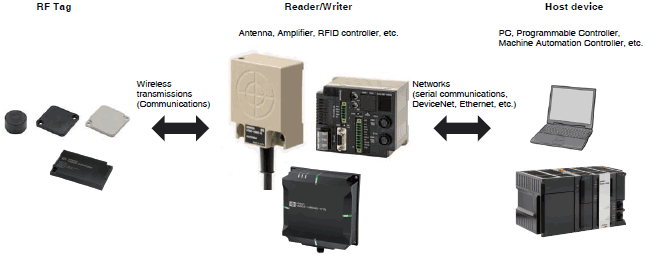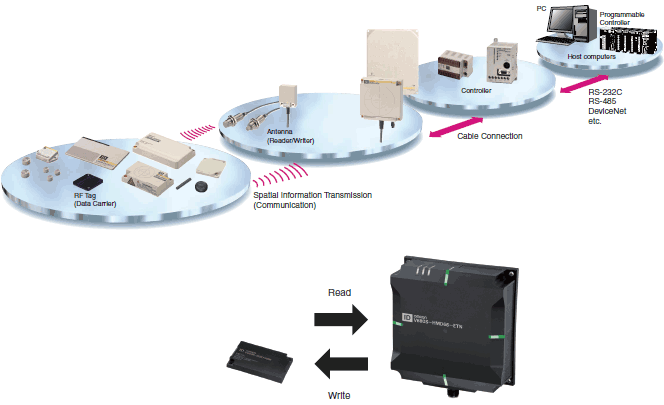What is RFID and What Are the Functions of RFID?
- Share
- Issue Time
- Sep 1,2021
Summary
Welcome to RFID Guide!! In this guide, we will introduce you the RFID technology on what is RFID, how does rfid work, and application of rfid. If any questions, just free to contact us. Thank you.

What is radio frequency identification (RFID)?
RFID is a radio wave-based technology used to monitor inventory. RFID tags differ from barcodes because tracking chips doesn't need to be in-line with barcode scanners to return data. This makes them more useful for operators trying to find stock quickly and easily. Nearly all RFID systems operate on one of the following four frequency bands: low frequency (LF), high frequency (HF), UHF
|
LF
|
HF
|
UHF
|
|
Frequency |
125kHz,135kHz
|
13.56Mhz
|
860~960Mhz
|
HOW DOES RFID WORK?
In its basic form, a typical RFID system has three major components, a reader (also called an interrogator) ,tags (also called transponders) and host devices.
The RFID system writes data sent from the host device to the RF tag via the Reader/Writer.
The data inside the RF tag are read through the Reader/Writer. Data inside the RF tag are rewritable.

RFID TAGS——SMART LABELS
As stated above, an RFID tag consists of an integrated circuit and an antenna. The tag is also composed of a protective material that holds the pieces together and shields them from various environmental conditions. The protective material depends on the application. For example, employee ID badges containing RFID tags are typically made from durable plastic, and the tag is embedded between the layers of plastic.
RFID tags come in a variety of shapes and sizes and are either passive or active. Passive tags are the most widely used, as they are smaller and less expensive to implement. Passive tags must be“ powered up ”by the RFID reader before they can transmit data. Unlike passive tags, active RFID tags have an onboard power supply (e.g., a battery), thereby enabling them to transmit data at all times.

What is the advantages of RFID technology?
1. Able to Read and Write data without direct contact
The RF tag can contain up to several kilobytes of rich information. All of the data required for each process (process history, inspection history etc) can be freely stored, without the need for direct contact. This makes it possible to develop paperless sites, where the causes of production stop are reduced.
2. By "combining an item with its information", a highly pliable and reliable system configuration becomes possible
With the technology to decentralize information, the load on higher systems is reduced. This means that system development costs can also be reduced, systems can be implemented significantly faster, and the system is much more flexible when making changes. Also, "the unification of items with their information" for each process and site can make it possible to manage production/processes and product quality without errors. And, with the latest information contained in RF tags, work can continue offline in emergencies, significantly shortening the time required to restore processes.
3. With the adoption of space transmission technology and protocols, highly reliable communication is made possible
As opposed to barcodes which simply look for 1 or 0, advanced space transmission technologies and specialized protocols are employed for transmission through the air. 16 bits CRC is added to the information as it is transmitted. More than 18 bits Burst errors can be detected at a ratio of 00.9985%, providing a very high reliability in the transfer. Also, since there are no mechanical devices involved such as with the Raster Scan method for barcodes, the likelihood of malfunction and other problems is greatly reduced.
4. Reading and writing is possible without line of sight, using electric and electromagnetic wave transmission
Unlike barcodes, since communication occurs by means of electric and electromagnetic waves, erroneous readings due to dirt, moisture, oil etc are cancelled out. Even if there is dust, moisture etc., or anything other than metal between the antenna and the RF tag,. it will not affect transmission. And since the communication range is wide, there is no need for extreme positioning which can greatly reduce the time and cost of design.
5. Can simultaneously access information of multiple RF tags
Some RFID systems are equipped with a function that allows you to simultaneously read the information of multiple RF tags existing within the transmissions area of the Reader/Writer.

Application:
RFID TECHNOLOGY IS EMPLOYED IN MANY INDUSTRIES TO PERFORM SUCH TASKS AS:
- Warehouse Management
- Supply Chain Management
- Vehicle Management
- Line Management
- Source Management
- Asset Management
- Personnel Management
- Attendance Management
- Product Anti-counterfeiting Management




